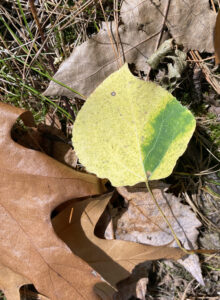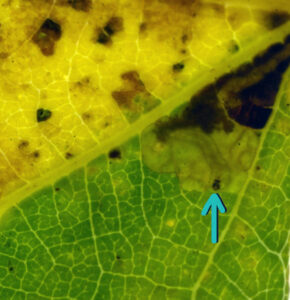
An aspen leaf that fell in the fall showing a “green island” due to leafminer feeding. / Photo Credit: Linda Williams, Wisconsin DNR
By Linda Williams, DNR Forest Health Specialist, Woodruff;
Linda.Williams@wisconsin.gov or 920-360-0665
Most aspen leaves that fell this fall were a beautiful yellow gold color, but every so often some could be found that were yellow with a green strip on them. Were the aspen trees supporting the Green Bay Packers? No. The green stripe was an indication of the presence of a tiny leafmining caterpillar.
Leafminers are tiny caterpillars that live and feed within a leaf. These tiny caterpillars may produce blotch mines or serpentine mines that create lines on the leaf.
In the case of the Packers-colored aspen leaves, the caterpillars create a blotch mine near the base of the leaf, where the petiole (the stalk from the stem) meets the leaf material. They feed between two veins, and this feeding prevents that area of the leaf from changing to fall colors.
In the fall, when the leaves turn gold and drop from the tree, the tiny caterpillars fall with the leaf to the ground. They pupate and spend the winter as a pupa, then emerge in the spring and restart the cycle.

Near the base of this leaf is a small, wedge-shaped feeding area which caused the leaf to have a “green island.” / Photo Credit: Linda Williams, Wisconsin DNR
There are two leafminers on quaking aspen that cause nearly identical damage and can only be differentiated by rearing out the adult moths. One species that might have caused the unique coloration in aspen leaves is Ectoedemia argyropeza (no common name), which is not native but can be found throughout North America wherever quaking aspen occurs. The other is an undescribed species that appears to be native. The adults look different, but both are tiny moths with feathery wings. For more info, and pictures of the two moths, check out this blog by Charley Eiseman.
The damage to the leaves is generally quite minimal and does not affect the tree’s ability to produce enough sugars for the year. So even if a significant proportion of leaves in the fall have these green areas, no control of this insect is necessary.

Under the microscope and backlit, it’s easy to see larvae feeding within this leaf. The arrow points at a leafminer’s head. / Photo Credit: Linda Williams, Wisconsin DNR
